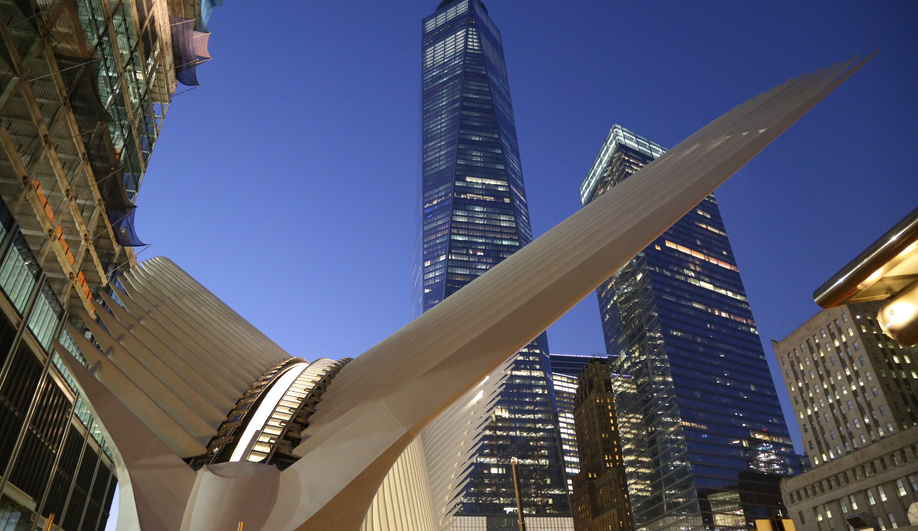When Manhattan gets a new building that takes 12 years to complete, from the unveiling of a concept to the first walkthroughs, and which costs from just under US$4 billion to $4.4 billion in taxpayer dollars (and what’s a few hundred million dollars here and there?), it’s going to get people talking. In this, if nothing else, Santiago Calatrava’s World Trade Center Transportation Hub is no exception.
Opened yesterday, the Hub occupies the site of a previous rail system, just east of where the World Trade Center’s Twin Towers once stood; like them, the previous system was destroyed on 9/11. Today, the Hub sits nestled between the WTC memorial fountains to the west and the gated cemetery of St. Paul’s Chapel to the east, with skyscrapers in various stages of completion rising all around. And like the previous rail station, Calatrava’s hub connects people at ground level, on Church and Greenwich Streets, to two concourses. Eventually to be filled in with retail and dining spots, these concourses ultimately lead to the subway and PATH train platforms, some 18 metres below grade, which carry commuters home to Hoboken and Newark, New Jersey.

While much of this labyrinth of corridors is underground, it’s the Oculus – the photogenic surface-level entrance, and the main section of the Hub to open to the public yesterday – that is attracting attention. Two sets of white-painted steel ribs line the Oculus’s lens-shaped footprint, rising to form a pair of arches that peak at a height of 107 metres; lined with glass, the structure glows like a lantern after sunset. Most striking are the two asymmetrical rows of massive spines that run from end to end along the length of the structure, seeming to reach out to the canyons of space that separate the surrounding towers. A 100 metre-long skylight, like a zipper running along the top of the Oculus’s ridge, can be opened in warmer weather to frame a narrow slice of the New York skyline and offer glimpses of SOM’s One World Trade Center tower, virtually next door.
Calatrava has compared his design to a bird released from a child’s hands, and no one could deny that the structure, with its elegant spines and soaring, cathedral-like ceiling, is beautiful – or so you’d think. But critics have been divided. Paul Goldberger, writing for Vanity Fair, is firmly in the hub’s corner, calling it a “genuine people’s cathedral” and “an architectural experience…that may renew your faith in the potential of the public realm in New York.” Others have not been so kind; Michael Kimmelman of the New York Times, through grudging admiration of the “jaw-dropping” view from inside, decries the hub as “a soaring symbol of a boondoggle” and goes on to say that it’s “shoehorned into an unfinished office park …. I no longer know what the hub is supposed to mean, symbolically, with its now-thickened ribs, hunkered torso and angry snouts on either end, weirdly compressing the entrances from the street. It’s like a Pokémon.”

Kimmelman’s reaction seems founded on an assumption that the Hub cannot be judged as a typical building would. Whether or not commuters can find their train is a secondary consideration; given the $4 billion investment of taxpayer money, the Hub must be held to a higher standard. Nothing less than a rarefied encounter with the essence of architecture will satisfy. Other writers seem to take the same tack; at Forward, Talya Zax calls it “too confusing and slightly too construction-bound to be truly spiritually compelling,” while at New York Post, Steve Cuozzo declares the hub “as functionally vapid inside as it is outside. It’s a void in search of a purpose other than to connect a bunch of subway and pedestrian corridors and concourses with one another.”
Justin Davidson of New York Magazine offers what is perhaps the most measured take on the issue – acknowledging, foremost, that the completion of anything outside the norm in the context of financial-district New York is an astonishing achievement. “It seems miraculous that Calatrava’s daydream should now finally exist, altered yet recognizable,” he says. “Its frame is a little less lithe, its skin a little less smooth, its concept more mature. What remains is an extravagantly idealistic creation unlike any in New York. It challenges the city’s public architecture to rise above habitual cut corners and rectilinear repetition. The cost of beauty is often high.”



